Da Nang highlights and travel guide
Danang has often been hidden in the shadow of its neighbouring cities, Hoi An and Hue. This coastal town on Vietnam's east coast, however, is beginning to get some of the recognition it deserves. Danang is Vietnam's fifth biggest city and boasts many of the modern amenities of Hanoi and Saigon but with a more relaxed, seaside vibe. Surrounded by stunning scenery with soft sandy beaches stretching along the shoreline and dramatic mountains inland, this fast developing city is attracting more and more visitors each year.
Danang hasn't always been the laid-back destination that exists today; it has seen years of difficulty and upheaval during the wars that plagued Vietnam. Initially established by the Cham people in 192 AD, temples and relics of the kingdom still remain scattered throughout the area. The Viet people overthrew the Cham kingdom and took control in the 2nd century. In 1835, the strict Confucian King, Minh Mang, was on a crusade to stymie the influence of European missionaries. As part of his efforts, the king prohibited any European vessels from doing trade in any harbours except Danang. The successful trade in Hoi An was transferred to Danang, which, in turn, stole the limelight as one of the country's major ports.
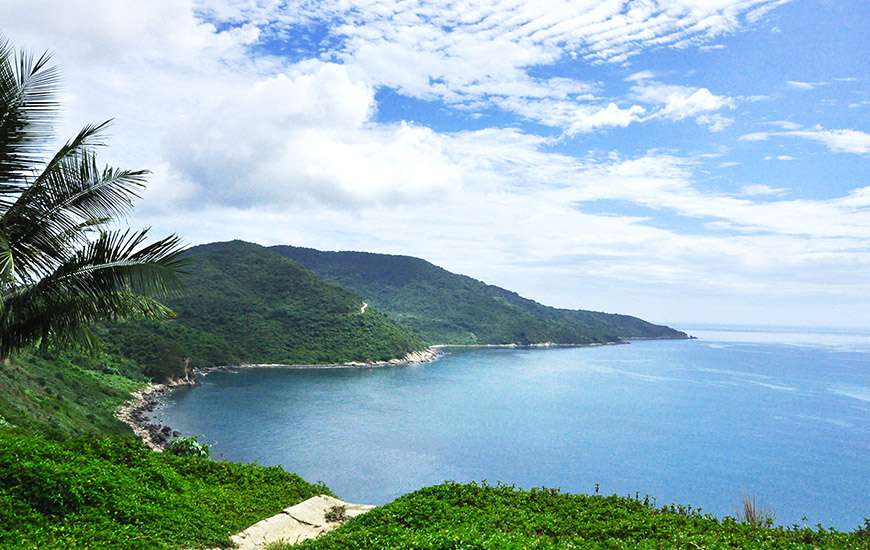
A view of Son Tra Peninsula from a viewpoint.
From the beginning of the siege of Tourane (the name given to Danang by the French) in 1858 onwards, Danang became the subject of a power struggle between the French and Vietnamese. In 1888, after previous victories against the French, King Dong Khanh relinquished power over Danang to France. Under the new French rule, Danang was renamed Tourane and was developed using European infrastructure and technology. In 1945, after the Vietnamese Declaration of Independence by Ho Chi Minh, Tourane's name was changed to Thai Phien City in honour of the Vietnamese rebel who fought against the French Authorities. After a short period as Thai Phien, the city's name was restored to Danang.
The city saw more of the destruction of war in 1965 when American Marines landed in Danang and began the construction of a large military base. During the following years, many people fled from the dangers of the city into refugee camps. It wasn't until 1975 that Danang was fully liberated and the long, arduous process of rehabilitation could begin.
Although much of the area was devastated by the effects of war, and many war wounds still remain, the restoration of Danang has been, for the most part, a success. Over the past decade or two, Danang has seen large investments from the tourism industry with many impressive hotels and resorts being built in the city and along the coast. The most majestic symbol of Danang's revival is the 666-meter Dragon Bridge which strikes across the Han River. This dramatic creation was constructed to celebrate the 38th Anniversary of the liberation of Vietnam. The bridge is adorned with a dragon that comes to life by night, illuminated by colourful lights and breathing fire from its fearsome mouth.
Danang's revival has seen a spike in interest with many more people flocking to discover the amazing natural beauty and laid back atmosphere.
Danang's revival has seen a spike in interest with many more people flocking to discover the amazing natural beauty and laid back atmosphere.
See and Do
One of Danang's main draws are the long sandy white beaches that stretch lazily along its peninsula. One of the most popular beaches is My Khe. Just a short distance from the city centre, this beach comes alive at sunrise as many people gather to greet the day with thai-chi and gentle exercise. Once the sun is high in the sky and radiating its powerful rays across the white sand, the beach is deserted by locals and frequented mainly by tourists. The long stretch of sand, dotted with palm umbrellas and round, weaved boats, feels like a paradise far away from the city. There are numerous other beaches, each with their own charm. North of Danang are some more secluded, undeveloped beachs such as Lang Van, which is reached from a path off of the Hai Van Pas.
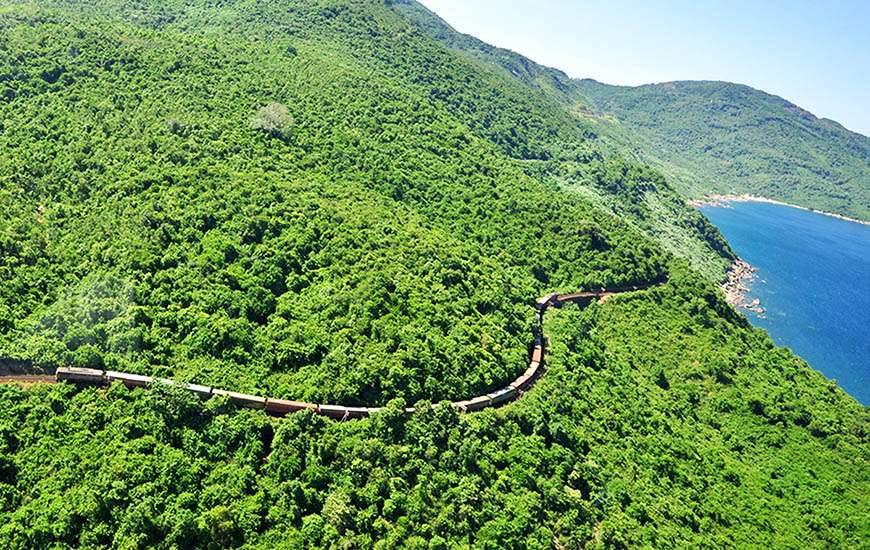
A train moving through the famous Hai Van pass.
Danang has a small ion of interesting museums showcasing items from as far back as the Champa Kingdom. The Museum of Cham Sculpture illustrates the creativity and skill of the people that once settled Danang. The collection features many detailed sculptures of the Hindu gods which were once worshipped here. The Danang Museum has a broader coverage of the history of Danang. The wide-ranging ion of artefacts tells the story of Danang and the people that have lived there over the years. The Zone 5 Military Museum takes a look back in history at all of the wars fought against foreign invaders. Outside of the museum are a number of stern military vehicles which set the scene for what's inside. Also, adjacent to this, is the Ho Chi Minh Museum dedicated to the life and works of the national treasure. Just outside of the city, set high in the hills, 1487 meters above sea level, is the fairy tale esque, Ba Na Hills. Possibly the most exciting part of the trip is the journey up into the mountains on the world's longest continuous cable car. The small cars whisk visitors up over the thick carpet of forest that covers the mountain and high into the clouds and on a clear day the views of the coastline are magnificent. The park itself features beautiful temples and pagodas, a French village, manicured gardens and other more modern attractions.
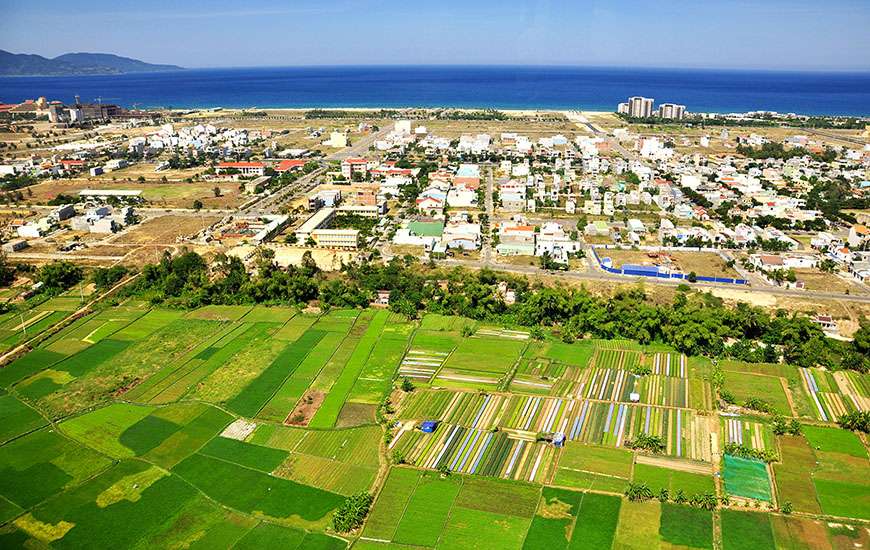
Da Nang City from a helicopter.
The astounding natural beauty of the region can be seen in the areas surrounding the city . One of the best places to experience this, and arguably one of the most incredible stretches of road in the country, is the Hai Van Pass. Infamous for its many years of inaccessibility and history as a dividing force, the stunning stretch of road is now a scenic route for motorbikes and a handful of lorries. Since the construction of a tunnel through the mountains, the majority of road traffic does not venture up the dizzying road making for safer and more enjoyable journey. The summit of the pass, at a hair-raising 496-meters, is the only viewing point and offers unrivalled panoramic views that stop all visitors in their tracks. The peak features a small, bullet-marked fortress which is a stark reminder of the destruction that plagued this incredible area. From here spectators can see the mountains, heavy with forests, which roll gracefully down to the cities and white shorelines before the land s off into the crystal waters.
Across the Danang Bay, opposite the Hai Van Pass is the equally stunning Son Tra Peninsula. This idyllic area juts out into the ocean and is covered with thick jungle forests and winding mountain roads. The coast is fringed with relaxing, sandy beaches and clean ocean waters. Son Tra is the ideal place to escape from the city and get back to nature. The jungles are home to many species of wildlife, including the rare red-shanked douc langurs, and the surrounding ocean is home to some amazing coral reefs.
Across the Danang Bay, opposite the Hai Van Pass is the equally stunning Son Tra Peninsula. This idyllic area juts out into the ocean and is covered with thick jungle forests and winding mountain roads. The coast is fringed with relaxing, sandy beaches and clean ocean waters. Son Tra is the ideal place to escape from the city and get back to nature. The jungles are home to many species of wildlife, including the rare red-shanked douc langurs, and the surrounding ocean is home to some amazing coral reefs.
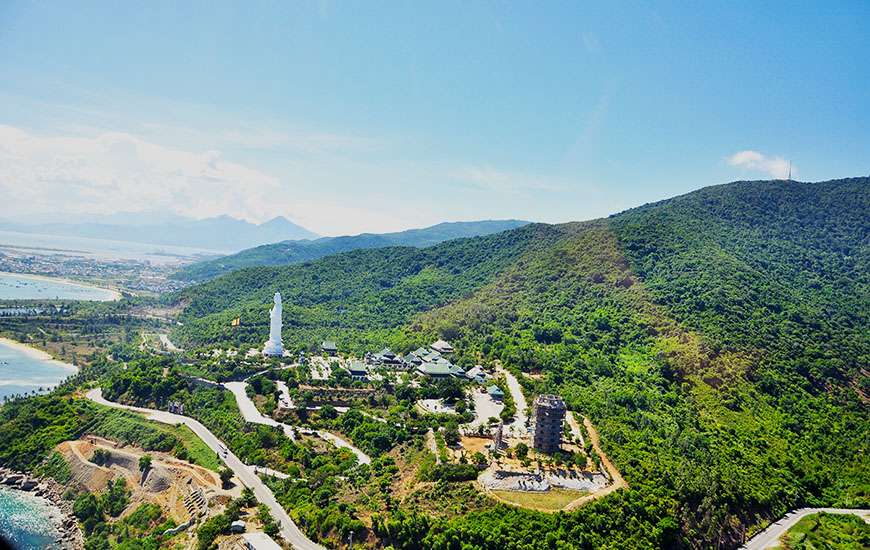
Linh Ung Pagoda, also from a helicopter.
Another fantastic feature of the Tra Son Peninsula is the towering Ling Ung statue. The dazzling white Goddess of Mercy sits atop lotus platform and gazes out over the sea. Inside the 67 meter high statue, there are 17 stories offering visitors views of the coastline. The power of the statue set against the dramatic scenery makes for a sight like no other. Just off the coastal road, to the south of Danang City, sits the dramatic, Marble Mountains. Each of the five imposing mountains is named after the five elements: water, earth, wood, fire, and metal. The jagged structures cut into the sky and are topped with temples and pagodas. The surrounding villages at the foot of the mountains have become famous for their incredible sculptures carved from marble. Here you can see the meticulous skill that goes into the making of each sculpture. The largest of the mountains, Thuy Son, Water Mountain, is accessible to visitors and is home to some captivating temples, some of which were originally Hindu and were later converted to Buddhism. They are set in atmospheric caves and grottoes dotted throughout the mountain. As well as offering a great insight into the religious traditions of the area, the views from the mountain are remarkable.
Arts and Culture
Danang has an interesting collection of multicultural places of worship, one of which is the Cao Dai Temple. The palatial architecture is painted in bright yellow with colourful details and the Divine Eye painted above the entrance. Inside is just as impressive with bright colours, gold details and lots of religious iconographies. The temple has daily services and is thought to serve approximately 50,000 followers of the Cao Dai religion.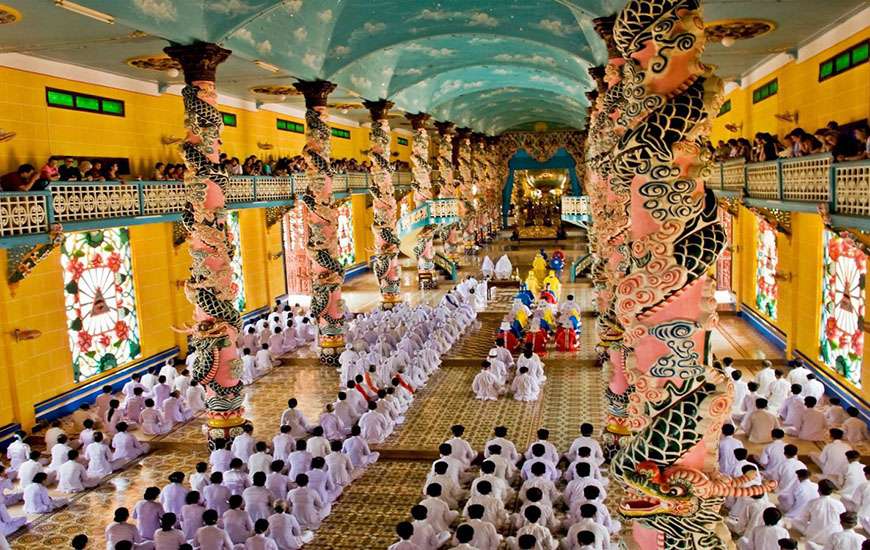

Cao Dai Temple and Tuy Loan Ancient Village.
One of the most impressive Buddhist places of worship in the area is the Phap Lam Pagoda. The pagoda sits in a serene garden with rows of beautifully kept potted trees. In the courtyard is a 1.1-meter high statue of Buddha in a seated position accompanied by the Goddess of Mercy and Dai The Chi Bodhisattva. Inside there is also a gold statue of the Buddha. The atmosphere of the Phap Lam Pagoda comes alive when the resident monks complete their daily chanting.
Due to the heavy European influence and the missionaries that lived her over the years, Danang also has a large Catholic Cathedral. Built in 1923 by the French Priest Louis Vallet in 1923, the distinctive, pink building has been kept in immaculate condition. It holds daily services in different languages and serves a large number of Catholics in Danang and the surrounding areas.
Although Danang city may seem very modern and developed with the bright lights and hotel resorts, there are still plenty of areas to get a glimpse into a more traditional way of living. Tuy Loan Village is just 15 km from Danang but feels like a whole world away. This rural area features gurgling rivers, green rice fields and traditional temples. Here the traditional trade of rice paper production is kept alive and passed from generation to generation. What makes this village's rice paper unique is the blend of spices and condiments that are added to the rice paper. Also instead of the usual method of sun-drying, the people here dry the rice paper using charcoal to prevent mould formation. The white round discs are placed on row upon row of wooden frames, the white colour reflecting the warm glow of the sun. Also produced here are the local speciality of my quang noodles. Tuy Loan is a great place to see how traditional techniques are kept alive.
Due to the heavy European influence and the missionaries that lived her over the years, Danang also has a large Catholic Cathedral. Built in 1923 by the French Priest Louis Vallet in 1923, the distinctive, pink building has been kept in immaculate condition. It holds daily services in different languages and serves a large number of Catholics in Danang and the surrounding areas.
Although Danang city may seem very modern and developed with the bright lights and hotel resorts, there are still plenty of areas to get a glimpse into a more traditional way of living. Tuy Loan Village is just 15 km from Danang but feels like a whole world away. This rural area features gurgling rivers, green rice fields and traditional temples. Here the traditional trade of rice paper production is kept alive and passed from generation to generation. What makes this village's rice paper unique is the blend of spices and condiments that are added to the rice paper. Also instead of the usual method of sun-drying, the people here dry the rice paper using charcoal to prevent mould formation. The white round discs are placed on row upon row of wooden frames, the white colour reflecting the warm glow of the sun. Also produced here are the local speciality of my quang noodles. Tuy Loan is a great place to see how traditional techniques are kept alive.
Food and Drink
Much like the rest of Vietnam, Danang has some mouthwatering specialities that must be tasted whilst in the region. The most famous dish is My Quang, named after Quang Nam province. The thick rice noodles, often seasoned with turmeric to give a rich yellow colour, are topped with a mixture of succulent meat and shrimp, fresh vegetables, peanuts and rice crackers. Unlike other traditional noodle dishes, only a small amount of broth is served with the meal. The medley of flavours, textures, and colours in this dish all work harmoniously together to create an interesting and flavour some meal.
Another local speciality is Bun Cha Ca. Noodles are served in an aromatic broth with the sweet flavours of pumpkin and pineapple, fresh herbs and Mam Tom (shrimp paste). The main piece of the dish is the fish dumplings that are made using a variety of different types of fish.
Another local speciality is Bun Cha Ca. Noodles are served in an aromatic broth with the sweet flavours of pumpkin and pineapple, fresh herbs and Mam Tom (shrimp paste). The main piece of the dish is the fish dumplings that are made using a variety of different types of fish.
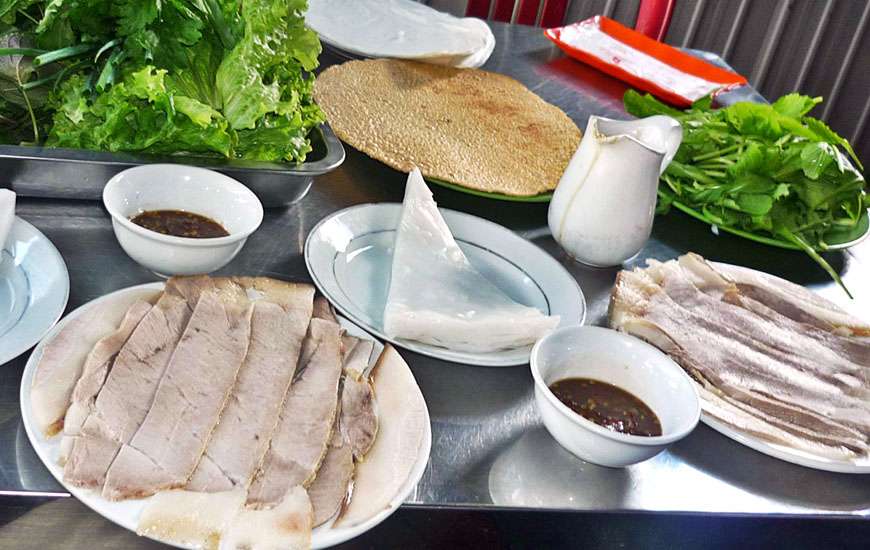
Banh Trang Cuon Thit Heo, a classic meal in Da Nang.
A more unusual seafood dish is Nam o sashimi. This meal consisting of raw fish in a fiery sauce originated from a small fishing village at the base of the Hai Van Pass. The fresh herrings or anchovies are marinated in herbs, salts and spices and rolled in crushed peanuts. They are served with fragrant herbs and fresh vegetables all rolled up in rice paper and dipped into a delicious sauce.
Banh Trang Cuon Thit Heo is also a rolled rice paper dish but this time the main ingredient is pork. Colourful, fresh ingredients are served on plastic plates ready for the customer to create their own rolls of rice paper, rolled pork and vegetables. The softness of the pork and the rice paper is beautifully complimented by the fresh crisp bite of the vegetables.
Festivals and Events
Danang celebrates numerous traditional and modern festivals throughout the year, each one celebrating a fascinating aspect of local culture. The Cau Ngu Festival or Fisherman's Festival is held after the lunar new year, at the beginning of the new fishing season. During the festival, there is a whale worshipping ceremony in which people pray for peace and safety. The whale is a sacred animal in Vietnam, given the honourable title, Mr Whale, due to the belief that whales have come to the aid of many ships in times of danger. People also pray to their ancestors and to the sea to ask for safety and profitable catches in the upcoming fishing season. The festival features many traditional games and activities such as fishnet weaving competitions and tug of war contests. The colourful parades featuring decorated boats and people wearing traditional costume bring excitement to the streets. Cau Ngu Festival is a great way to enjoy the local fishing culture and see the strong sense of unity in the fishing community.
Another traditional festival, which was on hiatus between 1962-1991 but an annual event, is the Guan Yin Festival. Guan Yin, also known as the Goddess of Compassion or Avalokitesvara, is believed to have the power to help all creatures. The annual festival is held on the 19th day of February of the lunar calendar and takes place over three days. Guan Yin Festival opens with atmospheric rituals to welcome light, which symbolises intelligence and purity, into the lives of the people. This is followed by prayer ceremony to ask for peace, safety and national security. After the completion of all of the ceremonies, there is a great festival where people enjoy carnivals, arts, folk song and a vegetarian cooking course amongst other activities. People gather to flower lights into the river to pray for everlasting wisdom and at the same time creating a hypnotic flotilla of twinkling lights. Guan Yin Festival is a chance for people to gather and contemplate peacefulness and compassion.
Another traditional festival, which was on hiatus between 1962-1991 but an annual event, is the Guan Yin Festival. Guan Yin, also known as the Goddess of Compassion or Avalokitesvara, is believed to have the power to help all creatures. The annual festival is held on the 19th day of February of the lunar calendar and takes place over three days. Guan Yin Festival opens with atmospheric rituals to welcome light, which symbolises intelligence and purity, into the lives of the people. This is followed by prayer ceremony to ask for peace, safety and national security. After the completion of all of the ceremonies, there is a great festival where people enjoy carnivals, arts, folk song and a vegetarian cooking course amongst other activities. People gather to flower lights into the river to pray for everlasting wisdom and at the same time creating a hypnotic flotilla of twinkling lights. Guan Yin Festival is a chance for people to gather and contemplate peacefulness and compassion.
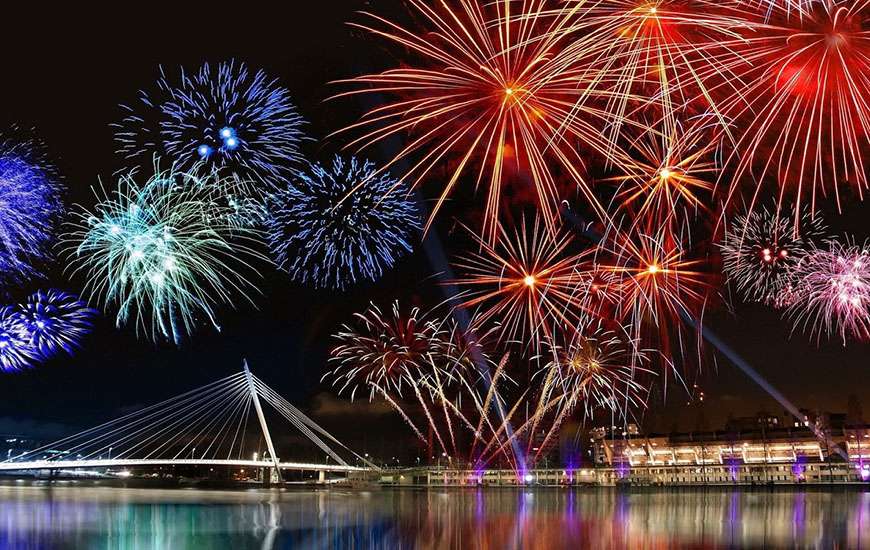
The Da Nang International Fireworks Competition is quite a show.
One of the more modern additions to Danang's many exciting festivals is the Danang International Fireworks Competition. Having only started in 2008, this event is held from the end of April to mid-June and has become very popular in a short amount of time. This spectacular event features displays from Vietnam, Australia, Austria, China, Italy, Japan, Switzerland, and The United Kingdom all competing to put on the best show. Each year has a different theme and the city roars into life with explosions of sound and colour filling the harbour. The event takes place on the banks of the Han River with the fireworks lighting up the whole harbour and creating a dramatic scene over the Dragon Bridge.
11/10/2023
175 View
New post
Da Nang highlights and travel guide
11/10/2023
Things to do in Da Nang
11/10/2023
The best places to visit in Da Nang
11/10/2023
Da Nang Overview
11/10/2023












